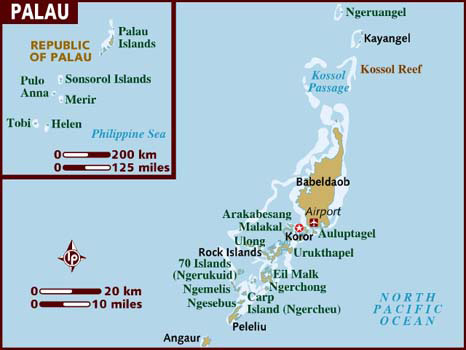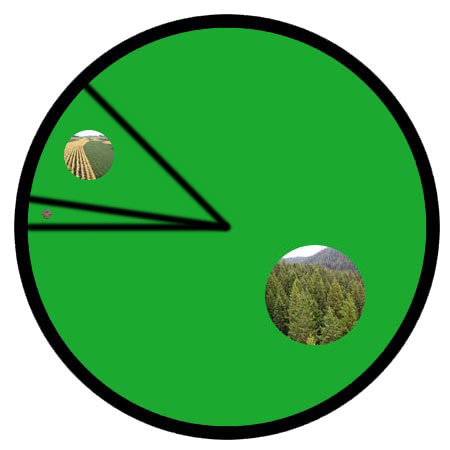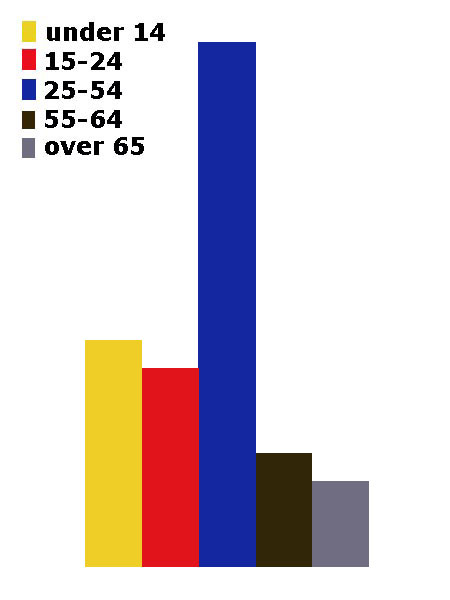Where is Palau?
About Palau
The Land
The People
Life and Death
Health, Energy and the Environment
Education and Work
Travel, Communication and the Media






Back to the Flags of Oceania page




Palau is a group of some 200 volcanic and coral islands which form one country in Oceania. Together with 4 other countries they form an island group known as Micronesia.
Palau is in the Pacific Ocean.
The islands vary enormously from high mountains to low coral atolls.
The geographical coordinates for the centre of Palau, also known as lines of latitude and longtitude, are:-
Latitude - 7 30N
Longitude - 134 30E


Check the weather in Koror now. Koror is the former capital, just 20kms south east of the new capital.
This is the time in Ngurelmud now
 The Palauan flag is light blue with a
yellow circle, slightly to the left of centre.
The Palauan flag is light blue with a
yellow circle, slightly to the left of centre.
Palau is a presidential republic with a President as head of government and head of state. It has a free association with the US.
In elections everyone over the age of 18 can vote.
The currency in the Palau is the US dollar.
Palauan and English are the official languages.
Hear the National Anthem
These are the anthem words
We have already written our own history of England but are asking schools in Palau to provide us with a detailed history of
their own country. Check how here.
![]()
![]() Back to the top
Back to the top

The total land area of Palau is 459 sq kms which is the 11th largest in Oceania.
Palau has no lakes, rivers and canals.
Palau has no boundaries with other countries
.
Palau has a coastline of 1,519 kms which is the 7th longest in Oceania.
The highest point in Palau is Mount Ngerchelchuus at 242 metres.


The total population of Palau is 21,431 people, making it the 8th largest country in Oceania by population.
Of this number 10,284 are females and 11,147 are males.
A person from Palau is called a Palauan.
To be a citizen of Palau, one of your parents must be a citizen of Palau. It is not sufficient to be born in Palau.
The largest five cities in Palau, by population are:-
- Koror on Koror 14,000 people
- Koror Town on Koror 12,676
- Kloulklubed on Peleliu 702
- Ulimang on Ngaraard 581
- Mengellang on Ngaraard 488
 Each little Owlbut is 1 person and
the big yellow rectangle is 1 sq km. After a while you can compare countries and see which ones are the most crowded. Remember it is only an average as
more people live closer together in towns and cities than in villages out in the country.
Each little Owlbut is 1 person and
the big yellow rectangle is 1 sq km. After a while you can compare countries and see which ones are the most crowded. Remember it is only an average as
more people live closer together in towns and cities than in villages out in the country.

87.1% of the people live in cities or towns.

The birth rate in Palau is 11.2 births per 1,000 of population
The death rate in Palau is 8.0 deaths per 1,000 people.
Check this against the birth rate. If the death rate is higher than the birth rate then
the population will decrease unless immigrants arrive in the country.
There are 9.3 deaths of girls under 1 year per 1,000 of births and 12.4 deaths of boys.
The median age for females is 34.7 and for males is 32.7. The median age is that age which divides the population exactly in half so there are the same number
of people above the median age as below it.
We have no figures for the average age of a woman when she has her first child.
The elderly dependency ratio is 11.8. This is the number of elderly people (ages 65+) per 100 people of working age (ages 15-64).
The potential support ratio is 8.5. This is the number of working-age people (ages 15-64) per one elderly person (ages 65+). As a population ages, the potential support ratio tends to fall, meaning there are fewer potential workers to support the elderly.



Palau spends 9.0% of its total income on health care.
There are 1.38 doctors per 1,000 people.
There are 4.8 hospital beds per 1,000 people.
55.3% of the population are estimated as obese.
97.0% of the urban population and 86.0% of the rural population have drinking water that is either piped into their home or they have access to a public tap, a protected borehole, well, spring or
protected rainwater collection facility.
100% of the population have access to a flushing toilet that is connected to a sewer. a pit latrine (that is a
permanent hole in the ground that is looked after) or a composting toilet.
We have no figures for the amount of carbon dioxide released by burning fossil fuels in the process of producing and consuming energy.

We have no figures of how much Palau spends of its total income on education.
Children usually start school at age 6 in Palau. Primary education is for six years until age 12 and secondary education must continue till 16 but
can go on to 18/19. There are no opportunities for further education in Palau.
Generally the school year consists of 4 terms and starts in the first week of August and finishes at the end of May. There is usually a 1 week
break at Christmas between terms 2 and 3.
86.0% of females and 96.8% of males are able to read and write by the age of 15.
We have no figures for the number of people aged between 16 and 24 who are not in work.
The total number of people available for work in Palau is 11,610.
 They work in the following sectors.
They work in the following sectors.
- Agriculture includes farming, fishing and forestry work
- Industry includes mining, manufacturing, construction and energy workers
- Services is everything else

There is 1 paved airport in Palau, which is the 14th highest number in Oceania.
![]()
There are no railways in Palau.
![]()
There are 36 kilometres of roads in Palau, which means Palau is in 12th place for the most kilometres of roads in Oceania.
![]()
There are no major national newspapers in Palau.
There are 24,000 mobile phone users.
34% of the people have a fixed landline.

7,650 people have access to the internet at home via any device (computer or mobile).


